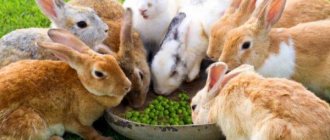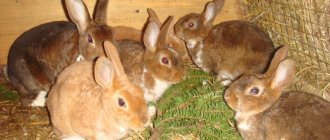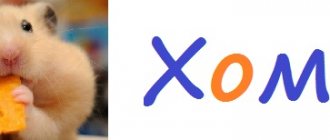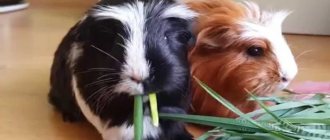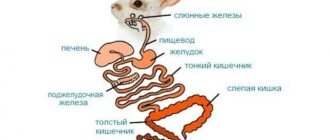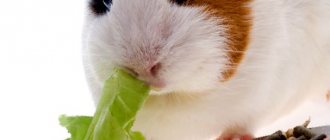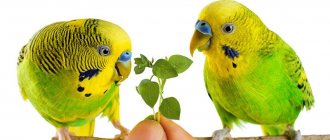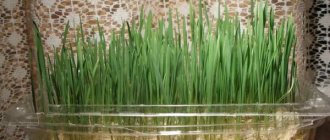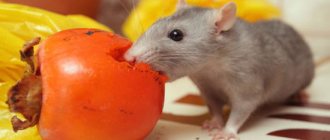Expert opinion
Dobryshev Sergey Anatolievich
Professional rabbit breeder and hare breeder with 30 years of experience
In addition to greens, roughage and succulent feed, the diet of rabbits must necessarily contain cereals, which is necessary for their full development and rapid weight gain. This food is healthy even for small rabbits.
What grains can be given to rabbits?
Even novice rabbit breeders know that rabbits need to be fed greens, vegetables and grains. But there are still some products that for some reason are rarely used and undeservedly forgotten. These include cereals and tree branches, which are of exceptional benefit. There are many other animal products, such as fish oil and bone meal, but today we’ll talk about porridge. What grains can be given to rabbits?
What should you not give?
Due to the characteristics of the gastrointestinal tract of rabbits, their diet should exclude the following foods:
- food from your table;
- frozen and stale food;
- root crops chemically treated during cultivation;
- grain crops affected by fungi;
- excessive salt;
- sprouted or green potato tubers;
- mango, avocado, persimmon, quince, orange, fig;
- rice, rye, millet;
- varieties of faba beans, red kidney beans and green peas;
- any dairy products;
- baked goods and sweets;
- poisonous plants;
- feed not intended for rabbits.
See also
Types of mini-farms for rabbits, drawings and how to make them yourselfRead
List of conditionally permitted products that can be given only occasionally and in limited quantities:
- tomatoes;
- cucumbers;
- onion;
- red cabbage;
- red beets;
- eggplant;
- unroasted sunflower and pumpkin seeds;
- dried fruits.
Cereals in the diet
Cereals should definitely be given; they are extremely useful even for baby rabbits. For the little ones, boiled millet is mixed with succulent food. Adults mix it with a variety of grains. There are many healthy cereals for rabbits: rice, pearl barley, oatmeal and flakes, millet, rolled oats and others. You can give the cereal whole or cook porridge and mash, then they are suitable even for small rabbits. Make sure that the food is fully cooked, otherwise it may cause damage. By the way, barley groats are considered the most useful.
What to feed for rapid growth and weight gain
In households, rabbits are raised mainly for meat. To fatten rabbits for meat at home, you can use various schemes, but protein and carbohydrate products are required. Grass and fresh vegetables still remain the basis of the diet, but it should also include grains of various crops, whole or crushed, cake and bran. For rapid growth, rabbits need to be fed legumes - green plant matter and ripe grains.
When the young animals grow up, in order to quickly gain weight, you need to feed the rabbits the food in which carbohydrates and fats predominate, that is, potatoes, grains, add animal feed - fish and meat and bone meal, concentrated milk powder, fish oil.
Is it possible to give pearl barley to rabbits?
In its composition, pearl barley is very similar to barley. But as a result of processing, it loses some of its nutrients. At the same time, the cereal remains extremely useful, especially for wool.
Nutritional value of pearl barley per 100 grams:
- Squirrels - 9.9 in the city.
- Fats - 1.16 g.
- Carbohydrates: - 62 g.
- Dietary fiber - 15 g.
- Ash - 1.1 g.
- Water - 10 g.
Nutritional content per 100 grams - 364 kcal. Cereals are very useful due to the content of the following substances:
- Vitamins: A, E, K, and group B.
- Macroelements: potassium, calcium, phosphorus, magnesium, sodium.
- Microelements: copper, selenium, iron, zinc, manganese.
You can offer self-made mixtures with grains, or buy ready-made ones. The mash contains up to 40% pearl barley, the rest comes from other products. For rabbits up to 5 months old, the content in the mixture does not exceed 20%. When selecting feed, make sure that the amount of cereal does not exceed 15% of the total mass.
Let's get back to dosages. An adult rabbit is given 80 grams per day. During the mating period - 95, during pregnancy - 85. It is recommended to change the portion every day, that is, give 60-95 g. In winter, one individual eats up to 180 g. Barley is given along with other products.
Nutrition of decorative breeds
If rabbits are bred not for meat, but for beauty, the feeding process changes somewhat. The diet itself remains approximately the same. It should also include fresh and dried grass, various gifts from vegetable gardens and orchards, animal feed, mineral and vitamin supplements. But you can’t just build a bunker feeder for your pet. He will become fat and will not live long.
Decorative rabbits require a special approach
It is important to maintain a balance between constant chewing and daily nutrient requirements, as well as to control your pet’s body weight. To ensure a natural feeding regime, it is worth purchasing feeder toys for your fluffy, which make it difficult for the animal to access food and force the animal to get it:
To ensure a natural feeding regime, it is worth purchasing feeder toys for your fluffy, which make it difficult for the animal to access food and force the animal to get it:
- balls made of metal wire for grass and pieces of vegetables (hanging and rolling on the floor);
- plastic balls for granulated food;
- “hedgehogs” made from twigs.
The advantage of such feeders is that the rabbit will be busy most of the day, and he will not have time for mischief.
Is it possible to give rolled oats to rabbits?
Rolled oat flakes are obtained by heat treatment of grain oats. Due to this, at a high cost, the nutritional value is slightly lower than that of ordinary oats. Moreover, it is quite useful. Often given to rabbits to speed up weight gain. Add to the diet of young animals with growth problems and weight gain. Make sure that your decorative rabbit does not overeat rolled oats, as this can lead to obesity.
Read also: How to make an enclosure for rabbits: detailed instructions, drawings and recommendations
You can serve it dry or steam it with boiling water for 5 minutes. Cooking is not recommended, as the porridge loses nutrients and can be harmful.
Hercules porridge is recommended for young animals up to 6 months old. At an older age, it is better to refrain from feeding this product. For adults, a mixture of finely chopped raw carrots and rolled oats is better.
Like other new foods, they need to be introduced into the diet gradually so that the body gradually gets used to them. Start with minimal doses and, in the absence of negative reactions, gradually increase.
Feeding standards
The feeder of a decorative rabbit should not be empty, since the consumed food moves through the intestines at the expense of the incoming one. A break in feeding leads to fermentation and rotting of feces, which can cause the death of the animal.
There is no specific rabbit feeding regimen. The main thing is to ensure the constant presence of hay, bark, branches of bushes and trees in the enclosure or cage. Twice a day, other food included in the diet of a decorative rabbit is supplied.
Important! The cage must have a drinking bowl with clean water.
Is it possible to give pearl barley to rabbits: or why do you need an accordion for your butt?
Pearl barley can certainly be given to rabbits. Idiomatic expressions in Russian such as why does a goat need an accordion, why does a goat need an accordion, are widely used in colloquial speech. Idioms express the meaninglessness of any action. In this case, the irony is expressed about feeding rabbits with a relatively expensive food product. Pearl barley is barley, a product purified from films and other useful surface parts of the grain. Why then is it considered that giving pearl barley to rabbits is just not reasonable?
Photo. Pearl barley can be fed to rabbits
What not to feed
On home farms, regardless of their size, rabbits should not be fed low-quality products: moldy, dirty and frozen root crops, fruits and vegetables, and raw hay. It is not advisable to feed potato and tomato tops, red beets, and red cabbage.
You cannot feed plants such as:
Flour products made from white flour, baked goods, and sweets are also not suitable for rabbits. Small rabbits should not be given unhulled barley; rabbits of any age should not be given apricots and plums with pits.
In order for rabbits to grow healthy and develop well, they need to be provided with adequate nutrition. Therefore, it is very important to properly plan their diet. So, many novice farmers have a question: can rabbits be given wheat? Experts recommend including it in your diet. It would be wise to give feed grains to rabbits, but only as a monofeed, otherwise it can cause bloating. Also, the wheat stalk should not contain pests, as this will negatively affect the health of long-eared pets.
Barley for people and rabbits
Several names are associated with pearl barley. Pearls are the ancient name for pearls. Soldiers eat shrapnel, a slang name for pearl barley porridge. Cereals that are intended for human consumption undergo special processing to give them a better presentation. Does the rabbit need a commercial type of porridge? In this case, the grain loses some of its useful substances in the surface films and scales. Well-cooked pearl barley porridge looks attractive in a dining room or even a restaurant and goes well with meat dishes. A person supplements the lack of nutrients with vitamins and minerals from other dishes.
How to feed it to animals correctly
Feeding your pets only regular whole grains is not a good idea; although it helps to wear down teeth, it is still quite difficult to digest and can lead to serious health problems.
So what grain should you feed your rabbits? Before purchasing wheat, you should inquire about its origin. You cannot buy cereals for feeding without checking the documents for them. You should be sure that they are not treated with harmful chemicals that can harm the health of the animal. Also, the grain for rabbits needs to be carefully inspected so that it is not dirty or covered with an oil crust.
Important! No matter how clean the wheat may seem, it is still better to wash and dry it before giving it to your pets. You should also pay attention to the conditions in which the grain is stored. Under no circumstances should it be left outdoors where it rains. It will definitely deteriorate and become unsuitable for feeding.
Also, beginning rabbit breeders often ask themselves: what is the best grain for rabbits? Today there are many species that would be acceptable to feed eared pets. Just don’t overuse rye bran; it’s better to replace it with wheat varieties.
And, having decided on what grain can be given to rabbits, this does not mean solving the problem. The health of animals also depends on the form in which the wheat was given. And the methods of preparing grain crops should be different. It should be given to pets raw, sprouted and steamed. By alternating food in this way, you can improve the animal’s digestion processes and provide the body with the necessary vitamins.
The health of animals also depends on the form in which the wheat was given.
Nutritional value of pearl barley and barley for rabbits
Refined grain contains a significantly depleted nutritional composition compared to coarse grain.
- 100 grams of pearl barley contains 224 kcal of metabolic energy. Vegetable proteins up to 3.2 grams, carbohydrates 22.3 grams, fats 0.4 grams.
- 100 grams of feed barley contains 280 metabolic energy, crude protein (protein) - 10.6, crude fiber (carbohydrates) 5.5 grams and crude fat 2.7 grams
I can’t vouch for the accuracy of the numbers, but it’s obvious that some of the nutritional properties are lost during grinding. Therefore, if you find on the Internet the same nutritional composition of barley and pearl barley, this is logically incorrect. Same for barley groats. Barley groats – dert (crushed grains). Nutrients are not lost; grinding is not provided for in the technology for producing this type of cereal.
Read also: Is it possible to give parsley and dill to rabbits?
Cost of feed barley and pearl barley for rabbits
Prices for feed and food products can fluctuate significantly depending on purchase volumes, regions, and inflation levels. It is very difficult to show an accurate picture in terms of value. However, the ratio of feed and food grains will remain correct even after several years.
In 2017-2018, the cost of barley and pearl barley:
- (animal feeding) feed barley is offered for approximately 7 rubles/kg.
- (human nutrition) pearl barley, average cost 21-24 rubles/kg.
Perhaps someone will find other figures that are more correct for a particular region, but the ratio will remain with approximately the same difference of 3 times.

